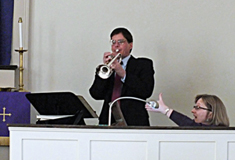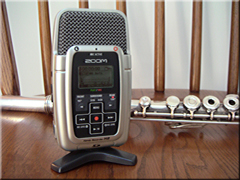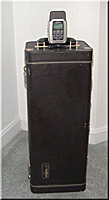David Summer on Location Recording
All Recordings © Copyright 2007 by David Summer
David Summer talks about location recording using the Zoom H2 Handy Portable Stereo Recorder. and provides demonstration recordings comparing the Zoom H2 built in mics with a professional quality recording microphone.
Recording on Location
Location recording will likely mean one thing to a recording engineer and another to a performing musician. The type of location recording I’m talking about here is accomplished using a small portable device to record your performance, sort of an “on the fly” recording procedure.
 Recording your performances can be useful for a musician in several ways. A recording can help you better judge how you are truly sounding to an audience. Listening to a recording of your performance (recording the gig) can help you determine how you might improve your performance skills. A recording can also serve as a record of the pieces you played at a particular venue. Also, although usually the controlled environment of a recording studio is better suited for making demonstration recordings, under the right circumstances, a live recording may also be used to create a demo.
Recording your performances can be useful for a musician in several ways. A recording can help you better judge how you are truly sounding to an audience. Listening to a recording of your performance (recording the gig) can help you determine how you might improve your performance skills. A recording can also serve as a record of the pieces you played at a particular venue. Also, although usually the controlled environment of a recording studio is better suited for making demonstration recordings, under the right circumstances, a live recording may also be used to create a demo.
Listen to virtually any CD recorded “live” at a performance and you will hear that the technical quality of the location recording is not likely to match that of a studio recording. However, a live recording, in front of an audience, can sometimes capture a certain spontaneity that’s more difficult to achieve in the controlled environment of a recording studio.
Portable Recording Devices
 When I first started recording on location, the recording device of choice was a portable cassette tape machine. These cassette tape recorders were prone to all of the problems inherent in using tape, including “wow” and “flutter” in the recordings as well as degradation of the recording over time. Premium cassettes were also relatively expensive, especially for a musician just starting out as I was.
When I first started recording on location, the recording device of choice was a portable cassette tape machine. These cassette tape recorders were prone to all of the problems inherent in using tape, including “wow” and “flutter” in the recordings as well as degradation of the recording over time. Premium cassettes were also relatively expensive, especially for a musician just starting out as I was.
Musicians started using Sony MiniDisc recorders in the 1990s, but I was holding out for something that would record in an uncompressed wave format, be really easy to use, run on common batteries and of course, sound great. Finally, in the fall of 2007, a recording device came along that fit that description, the Zoom H2 Handy Portable Stereo Recorder.
 For it’s size and price, this recorder produces an excellent recording. It’s easy to use, with a big red “Record” button and it takes two double-A batteries. The recorder includes a handy stand, cables, an AC adapter and a windscreen. Although it also comes with a 512 meg memory card, when I purchased mine, I also purchased a 4 gig memory card. This higher capacity memory card provides over 6 hours of uncompressed stereo recording in wave format. Currently, the Zoom H2 really has very few competitors in terms of price, ease of use and sound quality.
For it’s size and price, this recorder produces an excellent recording. It’s easy to use, with a big red “Record” button and it takes two double-A batteries. The recorder includes a handy stand, cables, an AC adapter and a windscreen. Although it also comes with a 512 meg memory card, when I purchased mine, I also purchased a 4 gig memory card. This higher capacity memory card provides over 6 hours of uncompressed stereo recording in wave format. Currently, the Zoom H2 really has very few competitors in terms of price, ease of use and sound quality.
This portable audio recorder will not produce the same level of quality recording as can be achieved using a professional recording microphone. As a comparison, I’ve recorded 2 short clips of my voice, one using the Zoom H2 built in mics and the other using a Neumann TLM-103 microphone, plugged into a Delta-66/Omni I/O PC recording interface. The difference in quality is clear. However, this is certainly like comparing apples and oranges, or even Corgis and German Shepherds.
When I use the Zoom H2 to record a performance, I usually place the recorder on the end of my trumpet case, somewhere out of the way. People rarely notice it. Only one person has ever asked me about it (another musician). By the way, if you’re a music teacher, band director or private music lesson instructor, this recorder is an excellent, easy way to record your students in their music lessons.
You can listen to several examples of the Zoom H2 handy recorder in action. David has used the Zoom H2 to record some of his special church service performances as a trumpeter and flutist. These location recordings demonstrate the ability of the Zoom H2 to capture a live performance, in this case in a church setting. The recorded performances include church choir, piano and organ as well.